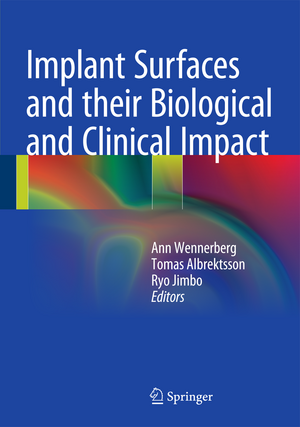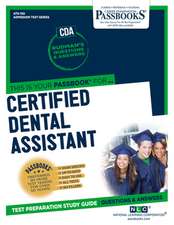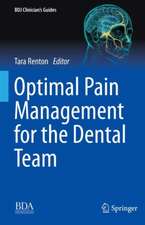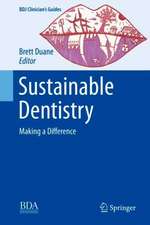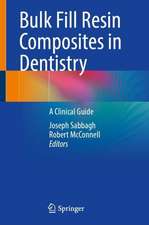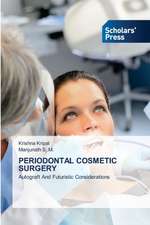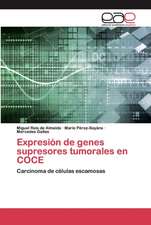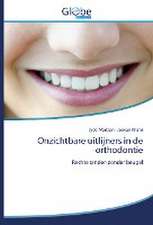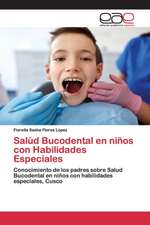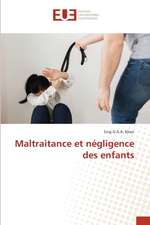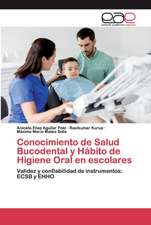Implant Surfaces and their Biological and Clinical Impact
Editat de Ann Wennerberg, Tomas Albrektsson, Ryo Jimboen Limba Engleză Hardback – 22 ian 2015
Preț: 662.34 lei
Preț vechi: 697.20 lei
-5% Nou
Puncte Express: 994
Preț estimativ în valută:
126.76€ • 131.85$ • 104.64£
126.76€ • 131.85$ • 104.64£
Carte tipărită la comandă
Livrare economică 11-17 aprilie
Preluare comenzi: 021 569.72.76
Specificații
ISBN-13: 9783662453780
ISBN-10: 3662453789
Pagini: 200
Ilustrații: XII, 182 p. 53 illus., 32 illus. in color.
Dimensiuni: 178 x 254 x 15 mm
Greutate: 0.59 kg
Ediția:2015
Editura: Springer Berlin, Heidelberg
Colecția Springer
Locul publicării:Berlin, Heidelberg, Germany
ISBN-10: 3662453789
Pagini: 200
Ilustrații: XII, 182 p. 53 illus., 32 illus. in color.
Dimensiuni: 178 x 254 x 15 mm
Greutate: 0.59 kg
Ediția:2015
Editura: Springer Berlin, Heidelberg
Colecția Springer
Locul publicării:Berlin, Heidelberg, Germany
Public țintă
Professional/practitionerCuprins
Basic Aspects: Surface Evaluations.- The “Four Parameters”.- Experimental and Clinical Knowledge: Surface Micro-Topography.- Importance of Surface Chemistry.- Importance of Surface Physics.- Importance of Surface Nano Roughness.- Novel Surfaces for Clinical Usage: Fluoride.- Anodization.- Fluoridated Surfaces in the Eyes of the Clinician.- Sandblasted and Acid etched Surfaces with or without High Surface Energy in the Eyes of a Clinician.- Anodized Surfaces in the Eyes of a Clinical Scientist.- Coated Implants.- Concluding Remarks and the Future.
Notă biografică
Ann Wennerberg, DDS, PhD, is Professor and Chair of the Department of Prosthetic Dentistry, Faculty of Odontology, Malmö University, Sweden. Prior to this appointment she had worked as Professor and Head of Prosthetic Dentistry/Dental Material at Göteborg University and as a researcher with the Swedish Medical Research Council. Dr. Wennerberg is also currently Vice Dean of the Faculty of Odontology at Malmö University. She has won a variety of awards, including the Acta Odontologica Scandinavica Award in 2008 for excellent contribution to dental research. Dr. Wennerberg is an editorial board member for the International Journal of Prosthodontics, the Journal of Oral Rehabilitation, and Acta Biomaterialia. She is the author of more than 160 original papers in international referee peer-reviewed journals, as well as 33 book chapter and reviews.
Tomas Albrektsson, MD, PhD, ODhc, was Professor and Head of the Department of Handicap Research (now the Dept. of Biomaterials), Department of Clinical Sciences, University of Göteborg between 1986 and 2012 and is currently visiting professor at Malmö Dental University. Dr. Albrektsson cooperated with Per Ingvar Brånemark in the development of osseointegrated oral and craniofacial clinical treatment, achieving international breakthroughs in 1982 and 1992. He is on the editorial boards of eight international scientific journals, and has been Editor-in-Chief of Applied Osseointegration Research since 2000. He has delivered more than 1000 invited lectures to professional audiences all over the world and has published very extensively, achieving an H index of 54. Dr. Albrektsson is the recipient of many awards, including most recently the American Prosthodontic Society Gold Medallion Award.
Ryo Jimbo, DDS, PhD, graduated from the Nagasaki University School of Dentistry in 1994 and subsequently gained his doctorate for work on enhancement of osseointegration by the chemotacticactivity of plasma fibronectin for cellular fibronectin positive cells. He is currently Docent/Associate Professor in the Department of Prosthodontics, Faculty of Odontology, Malmö University, Sweden, having previously worked as a postdoc in the department and as a research fellow at the Departments of Regenerative Oral Surgery and Applied Prosthodontics, Nagasaki University Graduate School of Biomedical Sciences, Japan as well as at Malmö University.
Tomas Albrektsson, MD, PhD, ODhc, was Professor and Head of the Department of Handicap Research (now the Dept. of Biomaterials), Department of Clinical Sciences, University of Göteborg between 1986 and 2012 and is currently visiting professor at Malmö Dental University. Dr. Albrektsson cooperated with Per Ingvar Brånemark in the development of osseointegrated oral and craniofacial clinical treatment, achieving international breakthroughs in 1982 and 1992. He is on the editorial boards of eight international scientific journals, and has been Editor-in-Chief of Applied Osseointegration Research since 2000. He has delivered more than 1000 invited lectures to professional audiences all over the world and has published very extensively, achieving an H index of 54. Dr. Albrektsson is the recipient of many awards, including most recently the American Prosthodontic Society Gold Medallion Award.
Ryo Jimbo, DDS, PhD, graduated from the Nagasaki University School of Dentistry in 1994 and subsequently gained his doctorate for work on enhancement of osseointegration by the chemotacticactivity of plasma fibronectin for cellular fibronectin positive cells. He is currently Docent/Associate Professor in the Department of Prosthodontics, Faculty of Odontology, Malmö University, Sweden, having previously worked as a postdoc in the department and as a research fellow at the Departments of Regenerative Oral Surgery and Applied Prosthodontics, Nagasaki University Graduate School of Biomedical Sciences, Japan as well as at Malmö University.
Textul de pe ultima copertă
This book provides the reader with the knowledge required in order to understand the chemical, physical, mechanical, and topographical aspects of implant surfaces, as well as their impact on the biological response. Common ways to modify implant surfaces are described, and methods for the evaluation of surface properties are presented in an easy-to-read style. Experimental results that have contributed to surface modifications relevant for commercial available implants are presented, with emphasis on in vivo and clinical studies. While the focus is primarily on surface modifications at the micrometer and nanometer levels, alterations at the millimeter level are also covered, including thread designs and their possible influence on stress distribution. In addition, it is analyzed how surface alterations have changed the clinical long-term results for certain groups of patients. Care is taken to ensure that assessments are well balanced and draw attention to the potential disadvantages of different surfaces; for example, surfaces that may be more prone to biofilm accumulation are identified, with discussion of the clinical evidence.
Caracteristici
Ideal source of information about implant surface treatments for clinicians Discussion of surface characteristics, surface-induced biological response, and bone formation Clear explanation of different coatings and their clinical application
